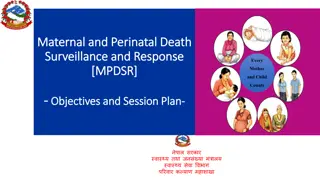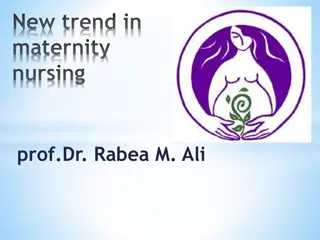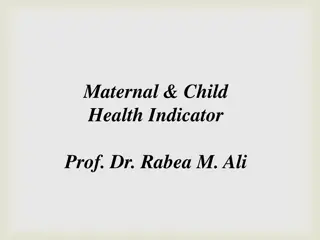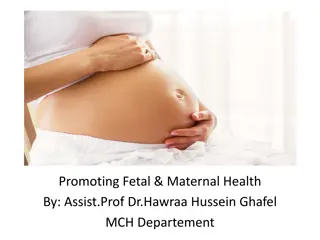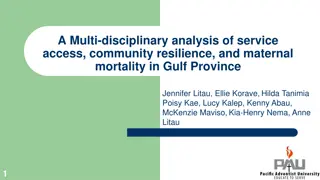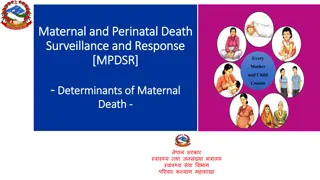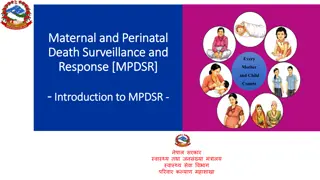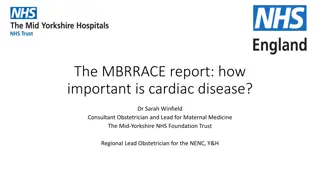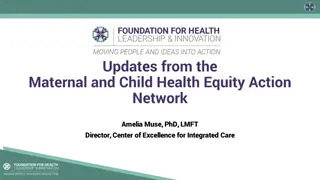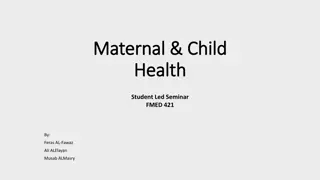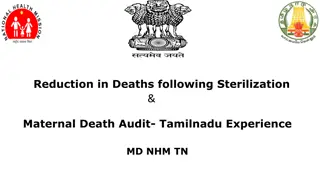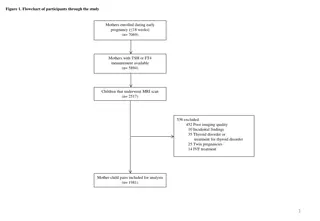Maternal Health Care and Family Planning Overview
Maternal health care and family planning are essential components of reproductive health. Family planning helps individuals achieve various objectives like avoiding unwanted pregnancies, controlling the timing and number of children, and regulating pregnancy intervals. The health benefits include preventing unwanted pregnancies, optimizing the number and timing of children born, and ensuring adequate gaps between pregnancies. Factors influencing family planning acceptance range from traditional and religious beliefs to economic and educational factors. Major maternal health problems postpartum, such as postpartum hemorrhage and pre-eclampsia, contribute significantly to maternal mortality, especially in developing countries.
- Maternal Health Care
- Family Planning
- Reproductive Health
- Postpartum Complications
- Acceptance Factors
Download Presentation

Please find below an Image/Link to download the presentation.
The content on the website is provided AS IS for your information and personal use only. It may not be sold, licensed, or shared on other websites without obtaining consent from the author. Download presentation by click this link. If you encounter any issues during the download, it is possible that the publisher has removed the file from their server.
E N D
Presentation Transcript
Family planning Family planning has been defined by WHO in following manner:- Family refers to practice that help individuals or couples to attain several objectives:- - To avoid unwanted pregnancy. - To control the time at which birth occur in relation to age of parents. - To determine the number of children in the family - To regulate the intervals between pregnancy.
Family planning includes all measures that enable the couple to have the numbers of children they desire, which include:- 1. Education and counseling on family planning. 2. Provision of contraceptives. 3. Management of infertility.
The health benefit of family planning The health benefit of family planning result from:- 1. The avoidance of unwanted pregnancy. 2. Change in total number of children born to a mother. 3. Achievement of an optimum interval between pregnancies (at least two year). 4. Change in time at which birth occur, particularly the first and the last pregnancy in relation to the age of mother.
Factors influencing the acceptance of family planning:- 1. Traditional. 2. Religious. 3. Political belief. 4. Economic. 5. Educational factors. 6. Mortality of children. 7. Family planning method
Major maternal health problems in the postpartum period A number of serious complications and the majority of maternal deaths occur in the postpartum period, especially in developing countries.
1. Postpartum haemorrhage This is the most important single cause of maternal deaths in the world. The majority of these deaths (88%) occur within 4 hours of delivery indicating that they are a consequence of events in the third stage of labour. The predisposing factors of which anaemia has to be one of the most significant.
2. (Pre) eclampsia This is the third most important cause of maternal mortality worldwide. Hypertensive disorders of pregnancy may start after 20 weeks gestation. But they are more common towards the end of pregnancy.
3. Puerperal genital infection Puerperal infections are still a major cause of maternal mortality in developing countries and to a lesser degree, in developed countries. Predisposing factors for puerperal genital infections are prolonged labour, prelabour rupture of the membranes, frequent vaginal examination, internal (vaginal) electronic fetal monitoring and caesarian section.
4. Thromboembolic disease In developed countries thromboembolic disease (TED) is a major cause of maternal mortality. In developing countries it is relatively less frequent than other causes like haemorrhage and infections. Pulmonary embolism is the serious manifestation of TED, and largely accounts for the mortality caused by it. Pulmonary embolism in the puerperium very often comes unexpectedly, without preceding clinical signs of deep venous thrombosis.
5. Complications of the urinary tract Retention of urine During the first days postpartum retention of urine with bladder distension is a frequent phenomenon. It is caused by several factors: during the second stage of labour the presenting part of the fetus, usually the head, presses against the urethra and the bladder and may cause oedema. Lacerations and pain in the vulvar region may also inhibit the voiding of urine. The changed anatomy in the lower abdomen after birth may reduce the sensation of the bladder.
During the first 12-24 hours after delivery bladder distension may gradually occur. The woman complains of increasing pain in the lower abdomen. And subsequently of the involuntary loss of small amounts of urine.
6. Puerperal mastitis In the early stages mastitis is probably mainly due to poor drainage of milk from part or all of the breast, due to poor sucking technique, and thus antibiotics are not indicated at this stage. Technique should be corrected. Breastfeeding should continue. Attachment of the infant to the breast to improve milk removal from the affected area. Antibiotics can be given if the condition does not improve within 12-24 hours or if the initial condition is very acute.
7. Psychological problems in the postpartum period Although the days after birth are generally considered a period of intense happiness, this period has its dark sides too. During some of these days or even during several weeks many mothers do not feel happy at all,
The postpartum period should be considered as a vulnerable time for the development of emotional and psychological disorders The last part of pregnancy and childbirth can be troublesome; the body goes through rapid changes, especially hormonal.
In the first days postpartum the body often feels painful and uncomfortable. The regular care of the baby involves new tasks and uncertainties and disturbs the night's rest, The relationship to the partner changes. Especially after the birth of a first child.




